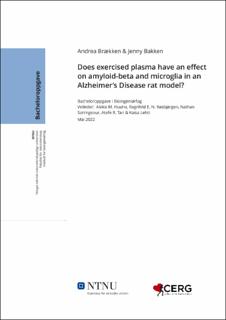| dc.contributor.advisor | Huuha, Aleksi M. | |
| dc.contributor.advisor | Lehti, Kaisa | |
| dc.contributor.advisor | Røsbjørgen, Ragnhild E. N. | |
| dc.contributor.advisor | Scrimgeour, Nathan | |
| dc.contributor.advisor | Tari, Atefe R. | |
| dc.contributor.author | Bakken, Jenny | |
| dc.contributor.author | Brækken, Andrea | |
| dc.date.accessioned | 2022-07-01T17:20:14Z | |
| dc.date.available | 2022-07-01T17:20:14Z | |
| dc.date.issued | 2022 | |
| dc.identifier | no.ntnu:inspera:106147449:107341438 | |
| dc.identifier.uri | https://hdl.handle.net/11250/3002159 | |
| dc.description.abstract | Risikoen for å utvikle Alzheimers sykdom (AD) øker med alderen, og på grunn av at forventet levealder øker, vil en større del av verdens befolkning bli berørt av sykdommen i fremtiden. Dette vil medføre en større belastning for helsevesen og omsorgspersoner, og en økt kostnad for verdenssamfunnet. Det er for øyeblikket ingen tilgjengelig kur som enten kan forhindre utviklingen eller behandle sykdommen, selv om behovet er økende.
Trening har blitt assosiert med redusert AD-risiko, noe som kan skyldes treningsinduserte forandringer i blodet. Plakkdannelse av amyloid-beta (Aβ) i subiculum-området i hjernen er et av de tidligste kjennetegnene på AD. Reduksjon av Aβ-dannelse i hjernen kan resultere i mindre plakkdannelse, som igjen vil kunne føre til mindre aktivisering av mikrogliaceller i hjernen. Mikrogliaceller er fagocyterende celler som overvåker hjernen for Aβ, og annet avfall. Ved fagocytering blir cellene aktive, som kjennetegnes med få og korte cellegrener.
For å undersøke om trent plasma kan ha gunstig effekt på Aβ-dannelsen, og aktiveringen av mikrogliaceller, ble rotter fra tre ulike grupper sammenlignet; ubehandlede vill-type-rotter, ubehandlede AD-rotter og AD-rotter som ble behandlet med trent plasma (ExPlas-rotter). Hjernevev fra rottene ble farget ved hjelp av en immunfluorescensprotokoll, og avbildet ved bruk av konfokalmikroskopi for å analysere mengde Aβ og morfologien til mikrogliacellene.
Resultatet viste en signifikant forskjell når det kom til det økte antallet mikrogliaceller i ExPlas-rottenes hjerne, sammenlignet med vill-type-rottene (p=0.008). Det var lengre cellegrener per mikrogliacelle i vill-type-rottene og ExPlas-rottene, sammenlignet med hjernene til AD-rottene (henholdsvis p=0.031, p=0,040), noe som indikerer mindre aktive celler. I ExPlas-hjernene var det flere endepunkter per mikrogliacelle, sammenlignet med hjernene til AD-rottene (p=0.040). På grunn av høye nivåer av det som antas å være autofluorescens, var det ikke mulig å gjennomføre de planlagte analysene på Aβ.
Vi fant ut at det var flere likheter mellom mikrogliacellene i vill-type-rottene og ExPlas-rottene, sammenlignet med AD-rottene. Mest sannsynlig indikerer dette at behandling med trent plasma på rotter med AD-patologi har en gunstig effekt på mikrogliacellenes tilstand | |
| dc.description.abstract | The risk of developing Alzheimer’s disease (AD) increases with aging, and due to increased life expectancy among humans, a larger proportion of the world’s population will be affected by the disease in the future. This will lead to a burden for healthcare systems and carers and a great financial cost for the world community. The need for medicine that prevents the development or treats the disease is increasing, and there is currently no available cure in this field.
Exercise has been associated with reduced AD risk, which might be partly due to exercise-induced changes in the blood. One of the earliest hallmarks of AD is the formation of amyloid-beta (Aβ) plaques in the subiculum region in the brain. The reduction of Aβ accumulation would reduce the formation of Aβ plaques, which would be reflected in less activation of microglial cells in the brain. The microglial cells are phagocytic cells that survey the brain for Aβ or debris. When phagocyting they become active, characterized by few and short branches.
To investigate if plasma from exercised donors could have a beneficial effect on Aβ accumulation and microglial activation state, rats from three different groups were compared; untreated wild-type rats, untreated AD rats, and exercised plasma-treated AD rats (ExPlas rats). The rat brain tissue was stained using an immunofluorescence staining protocol, imaged using confocal microscopy, and analyzed for quantity of Aβ and morphology of microglial cells.
The results show a significant difference when it came to the increased number of microglial cells in the ExPlas brains compared to the brains of the wild-type rats (p=0.008). There were longer branches per microglial cell in the wild-type rats and the ExPlas rats, compared to the brains of the AD rats (p=0.031, p=0.040, respectively), which indicates less active cells. In the ExPlas brains there were more endpoints per microglial cell compared to the brains of the AD rats (p=0.040). Due to the high level of what is presumed to be autofluorescence, the planned analyses of Aβ were not feasible.
We found that there were more similarities between the microglial cells in the wild-type rats and ExPlas rats, compared to the AD rats. This most likely indicates that exercised plasma treatment on rats expressing AD pathology has a beneficial effect on the microglial state. | |
| dc.language | eng | |
| dc.publisher | NTNU | |
| dc.title | Does exercised plasma have an effect on amyloid-beta and microglia in an Alzheimer’s Disease rat model? | |
| dc.type | Bachelor thesis | |
